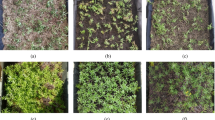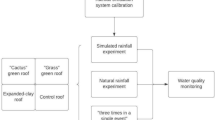Abstract
Purpose
The increasing surface area of green roofs (GR) may have a significant impact on the quantity and quality of urban drainage. However, the chemical quality of effluents produced by GR in comparison to atmospheric deposit and other roof surfaces has to date been poorly assessed. It is necessary to determine whether a green roof acts as a sink or source of pollutants. This work was conducted to study the capacity of four materials commonly used to build green roofs.
Materials and methods
Leaching tests experiments were performed on three substrates and one drainage material. Sorption kinetics and isotherms were also established for Cu and Zn thanks to batch experiments.
Results and discussion
Results showed the variability of release according to the material and pollutant considered. The equilibrium time for adsorption was high (5 h to 3 days) for all materials. Expanded clay was identified as the material with the highest ability to retain Zn and Cu; also, desorption was limited with this drainage material. In the substrates, Cu was mainly sorbed by organic materials, which induce an important desorption rate due to organic matter leachability.
Conclusions
In conclusion, the study showed that the effect of green roofs on water quality is strongly dependent on the materials used. That is why a characterization of the leaching and sorption capacities of materials should be carried out prior to green roof construction in a context of storm water quality management.





Similar content being viewed by others
References
Alsup S, Ebbs S, Retzlaff W (2010) The exchangeability and leachability of metals from select green roof growth. Urban Ecosyst 13:91–111
Alsup S, Ebbs S, Battaglia L, Retzlaff W (2012) Green roof systems as sources or sinks influencing heavy metal concentrations in runoff. J Environ Eng 139(4):502–508
Andersen KJ, Kisser MI (2004) Digestion of solid matrices. Desk study–Horizontal, 385 pp
Apiratikul R, Pavasant P (2008) Sorption of Cu2+, Cd2+ and Pb2+ using modified zeolite from coal fly ash. Chem Eng J 144:245–258
Arrêté du 25 janvier (2010) Relatif aux méthodes et critères d’évaluation de l’état écologique, de l’état chimique et du potentiel écologique des eaux de surface pris en application des articles R.212-10, R.212-11 et R.212-18 du code de l’environnement
Bhatnagar A, Sillanpää M (2010) Utilization of agro-industrial and municipal waste materials as potential adsorbents for water treatment—a review. Chem Eng J 157:277–296
Bhattacharyya AK, Mandal SN, Das SK (2006) Adsorption of Zn(II) from aqueous solution by using different adsorbents. Chem Eng 123:43–51
Bradl HB (2004) Adsorption of heavy metal ions on soils and soils constituents. J Colloid Interface Sci 277(1):1–18
Brown PA, Gill SA, Allen SJ (2000) Metal removal from wastewater using peat. Water Res 24(16):3907–3916
Conrad K, Bruun Hansen HC (2007) Sorption of zinc and lead on coir. Bioresour Technol 98:89–97
Czemiel-Berndtsson J, Emilsson T, Bengtsson L (2006) The influence of extensive vegetated roofs on runoff water quality. Sci Total Environ 355(1–3):48–63
Czemiel-Berndtsson J, Bengtsson L, Jinno K (2009) Runoff water quality from intensive and extensive vegetated roofs. Ecol Eng 35(3):369–380
Czemiel Berndtsson J (2010) Green roof performance towards management of runoff water quantity and quality: a review. Ecol Eng 36:351–360
Directive 2008/105 CE of the european parliament and of the council of 16 December 2008 on environmental quality standards in the field of water policy, amending and subsequently repealing council directives 82/176/EEC, 83/513/EEC, 84/491/EEC, 86/280/EEC and amending directive 2000/60/EC of the European parliament and of the council
Dunnet N, Kingsbury N (2008) Planting green roofs and living walls. Revised and updated edition, Timber Press, 327p
EN (2002) Characterisation of waste–leaching–compliance test for leaching of granular waste materials and sludges. Part 3: two stage batch test at a liquid solid ratio of 2 l/kg and 8 l/kg for materials with high solid content and with particle size below 4 mm (without or with size reduction) 12457–3
Eriksson E, Baun A, Scholes L, Ledin A, Ahlman S, Revitt M, Noutsopoulos C, Mikkelsen PS (2007) Selected stormwater priority pollutants—a European perspective. Sci Total Environ 383:41–51
Garnaud S (1999) Transfert et évolution géochimique de la pollution métallique en bassin versant urbain. Thèse de doctorat, Ecole Nationale des Ponts et Chaussées, 396 pp
Ghassabzadeh H, Mohadespour A, Torab-Mostaedi M, Zaheri P, Maragheh MG, Taheri H (2010) Adsorption of Ag, Cu and Hg from aqueous solutions using expanded perlite. J Hazard Mater 177:950–955
Gnecco I, Palla A, Lanza L, Barbera P (2013) The role of green roofs as a source/sink of pollutants in storm water outflows. Water Resour Manag 27(14):4715–4730
Ho YS, McKay G (1998) A comparison of chemisorption kinetic models applied to pollutant removal on various sorbents. Trans Inst Chem Eng 76(B):332–340
Köhler M, Schmidt M, Grimme FW, Laar M, de Assuncão Paiva VL, Tavares S (2002) Green roofs in temperate climates and in the hot-humid tropics—far beyond the aesthetics. Environ Manag Health 13(4):382–391
Lamprea K, Ruban V (2008) Micro pollutants in atmospheric deposition, roof runoff and storm water runoff of a suburban catchment in Nantes, France. 11th International conference on urban drainage, Edinbourg, Scotland, UK, 2008, 8 p
Li Y, Yue Q, Gao B (2010) Adsorption kinetics and desorption of Cu(II) and Zn(II) from aqueous solution onto humic acid. J Hazard Mater 178:455–461
Mar Areco M, Hanela S, Duran J, dos Santos AM (2012) Biosorption of Cu(II); Zn(II), Cd(II) and Pb(II) by dead biomasses of green alga Ulva lactuca and the development of a sustainable matrix for adsorption implementation. J Hazard Mater 213–214:123–132
Mays P, Edwards G (2001) Comparison of heavy metal accumulation in a natural wetland and constructed wetland receiving acid mine drainage. Ecol Eng 16:487–500
Mentens J, Raes D, Hermy M (2006) Green roofs as a tool for solving the rainwater runoff problem in the urbanized 21st century? Landsc Urban Plan 77(3):217–226
Minceva M, Fajgar R, Markovska L, Meshko V (2008) Comparative study of Zn2+, Cd2+ and Pb2+ removal from water solution using natural clinoptilolitic zeolite and commercial granulated activated carbon. Sep Sci Technol 43(8):2117–2143
Molineux CJ, Fentiman CH, Gange AC (2009) Characterising alternative recycled waste materials for use as green roof growing media in the U.K. Ecol Eng 35:1507–1513
Motsi T, Rowson NA, Simmons MJH (2009) Adsorption of heavy metals from acid mine drainage by natural zeolite. Int J Miner Process 92:42–48
Nehrenheim E (2005) Metal reduction from landfill leachate by using blast furnace slag and pine bark—discussion about the parameters significant for metal removal. Kalmar Eco-Tech’05, Sweden
Nehrenheim E, Gustafsson JP (2008) Kinetic sorption modelling of Cu, Ni, Zn, Pb and Cr ions to pine bark and blast furnace slag by using batch experiments. Bioresour Technol 99:1571–1577
Nwachukwu OI, Pulford I (2008) Comparative effectiveness of selected adsorbant materials as potential amendments for the remediation of lead, copper and zinc-contaminated soil. Soil Use Manag 24:199–207
Paradelo R, Barral MT (2012) Evaluation of the potential capacity as biosorbents of two MSW composts with different Cu, Pb and Zn concentrations. Bioresour Technol 104:810–813
Quek SY, Al-Duri B, Wase DAJ, Forster CF (1998) Coir as a biosorbent of copper and lead. Inst Chem Eng 76(Part B):50–54
Robert-Sainte P (2009) Contribution des matériaux de couverture à la contamination métallique des eaux de ruissellement. Thèse de doctorat, Université Paris-Est, 426 p
Sabin L, Lim JH, Stolzenbach K, Schiff K (2005) Contribution of trace metals from atmospheric deposition to stormwater runoff in a small impervious urban catchment. Water Res 39(16):3929–3937
Silber A, Bar-Yosef B, Suryano S, Levkovitch I (2012) Zinc adsorption by perlite: effects of pH, ionic strength, temperature and pre-use as growth substrate. Geoderma 170:159–167
Singh BR, Steinness E (1994) Soil and water contamination by heavy metals. In Soil processes and water quality, Edition Lewis, pp 233–271
Stovin V, Poë S, Berretta C (2013) A modelling study of long term green roof retention performance. J Environ Manag 131:206–215
US EPA (2005) National management measures to control nonpoint source pollution from urban areas. US EPA, Office of Water, 518 pp
Van De Voorde A (2012) Incidence des pratiques d’entretien des toitures sur la qualité des eaux de ruissellement - Cas des traitements par produits biocides. Thèse de doctorat, Université Paris Est, 277p
Van Seters T, Rocha L, Smith D, McMillan G (2009) Evaluation of green roofs for runoff retention, runoff quality and leachability. Water Qual Res J Can 44(1):33–47
Water framework directive (2000) 60 CE of the European parliament and of the council of 23 October 2000 establishing a framework for community action in the field of water
Acknowledgments
A multidisciplinary project has been launched in Nancy (France) with a wide partnership of academic and industrial actors (BATEC Lorraine, Végétoit, Saint-Gobain Weber Portugal, Falienor-Terreaux de France, Nidaplast, Comptoir du Bâtiment, Jardin Botanique de Nancy, association Floraine and Plante & Cité) to evaluate simultaneously the impact of GR on biodiversity, thermal isolation and rainwater quality.
We thank the Research and Innovation Direction of the French Ministry of Ecology, Ifsttar, Cerema and GEMCEA, which provided financial and technical support for this project. Thanks to Marie-Christine Gromaire (LEESU) for her feedback and advice.
Author information
Authors and Affiliations
Corresponding author
Additional information
Responsible editor: Gerd Wessolek
Rights and permissions
About this article
Cite this article
Schwager, J., Schaal, L., Simonnot, MO. et al. Emission of trace elements and retention of Cu and Zn by mineral and organic materials used in green roofs. J Soils Sediments 15, 1789–1801 (2015). https://doi.org/10.1007/s11368-014-0962-9
Received:
Accepted:
Published:
Issue Date:
DOI: https://doi.org/10.1007/s11368-014-0962-9




